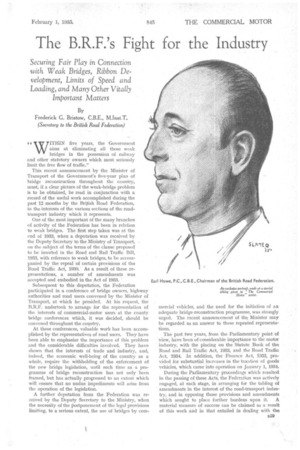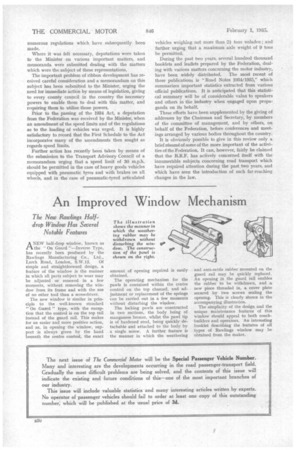The B.R.F.'s Fight for the Industry
Page 39

Page 40

If you've noticed an error in this article please click here to report it so we can fix it.
Securing Fair Play in Connection with Weak Bridges, Ribbon Development, Limits of Speed and Loading, and Many Other Vitally Important Matters ITHIN five years, the Government aims at eliminating all those weak bridges in the possession of railway
and other statutory owners which most seriously limit the free flow of traffic."
This recent announcement by the Minister of Transport of the Government's five-year plan of bridge reconstruction throughout the country, must, if a clear picture of the weak-bridge problem is to be obtained, be read in conjunction with a record of the useful work accomplished during the past 12 months by the Bripish Road Federation, in the interests of the various sections of the roadtransport industry which it represents.
One of the most important of the many branches of activity of the Federation has been in relation to weak bridges. The first step taken was at the end of 1933, when a deputation was received by the Deputy Secretary to the Ministry of Transport, on the subject of the terms of the clause proposed to be inserted in the Road and Rail Traffic Bin, 1933, with reference to weak bridges, to be accompanied by the repeal of certain provisions of the Road Traffic Act, 1930. As a result of these representations, a number of amendments was accepted and embodied in the Act of 1933. '
Subsequent to this deputation, the Federation participated in a conference of bridge owners, highway authorities and road users convened by the Minister of Transport, at which he presided. At his request, the B.R.F. undertook to arrange for the representation of the interests of commercial-motor users at the county bridge conferences which, it was decided, should be convened throughout the country.
At these conferences, valuable work has been accomplished by the representatives of road users. They have been able to emphasize the importance of this problem and the considerable difficulties involved. They have shown that the interests of trade and industry, and, indeed, the economic well-being of the country as a whole, require the withholding of the enforcement of the new bridge legislation, until such time as a programme of bridge reconstruction has not only been framed, but has actually progressed to an extent which will ensure that no undue impediments will arise from the operation of the legislation.
A further deputation from the Federation was received by the Deputy Secretary to the Ministry, when the necessity of the tiostponement of the legal provisions limiting, to a serious extent, the use of bridges by corn
mercial vehicles, and the need for the initiation of an adequate bridge-reconstruction programme, was strongly urged. The recent announcement of the Minister may be regarded as an answer to these repeated representations.
The past two years, from the Parliamentary point of view, have been of considerable importance to the motor industry, with the placing on the Statute Book of the Road and Rail Traffic Act, 7933, and the Road Traffic Act, 1934. In addition, the Finance Act, 1933, provided for substantial increases in the taxation of goods vehicles, which came into operation on January 1, 1934.
During the Parliamentary proceedings which resulted in the passing of these Acts, the Federation was actively engaged, at each stage, in arranging for the tabling of amendments in the interest of the road-transport industry, and in opposing those provisions and amendments which sought to place further burdens upon it. A material measure of success can be claimed as a result of this work and in that entailed in dealing with the numerous regulations which have subsequently been made.
Where it was felt necessary, deputations were taken to the Minister on various important matters, and memoranda were submitted dealing with the matters which were the subject of these representations.
The important problem of ribbon development has received careful consideration and a memorandum on this subject has been submitted to the Minister, urging the need for immediate action by means of legislation, giving to every county council in the country the necessary powers to enable them to deal with this matter, and requiring them to utilize those powers.
Prior to the passing of the 1934 Act, a deputation from the Federation was received by the Minister, when an amendment of the speed limits and of the regulations as to the loading of vehicles was urged. It is highly satisfactory to record that the First Schedule to the Act incorporates many of the amendments then sought as regards speed limits.
Further action has recently been taken by means of the submission to the Transport Advisory Council of a memorandum urging that a speed limit of 30 m.p.h. should be permitted in the case of heavy goods vehicles equipped with pneumatic tyres and with brakes on all wheels, and in the case of pneumatic-tyred articulated vehicles weighing not more than 2i tons unladen ; and further urging that a maximum axle weight of 9 tons be permitted.
During the past two years, several hundred thousand booklets and leaflets prepared by the Federation, dealing with various matters concerning the motor industry, have been widely distributed. The most recent of these publications is "Road Notes 1934/1935," which summarizes important statistics extracted from various official publications. It is anticipated that this statistical summary will be of considerable value to speakers and other § in the industry when engaged upon propaganda on its behalf.
These efforts have been supplemented by the giving of addresses by the Chairman and Secretary, by members of the committee of management, and by others, on behalf of the Federation, before conferences and meetings arranged by various bodies throughout the country.
It is obviously possible to give in this review only a brief resume of some of the more important of the activities of the Federation. It can, however, fairly be claimed that the B.R.F. has actively concerned itself with the innumerable subjects concerning road transport which have required attention during the past two years, and which have seen the introduction of such far-reaching changes in the law.




















































































